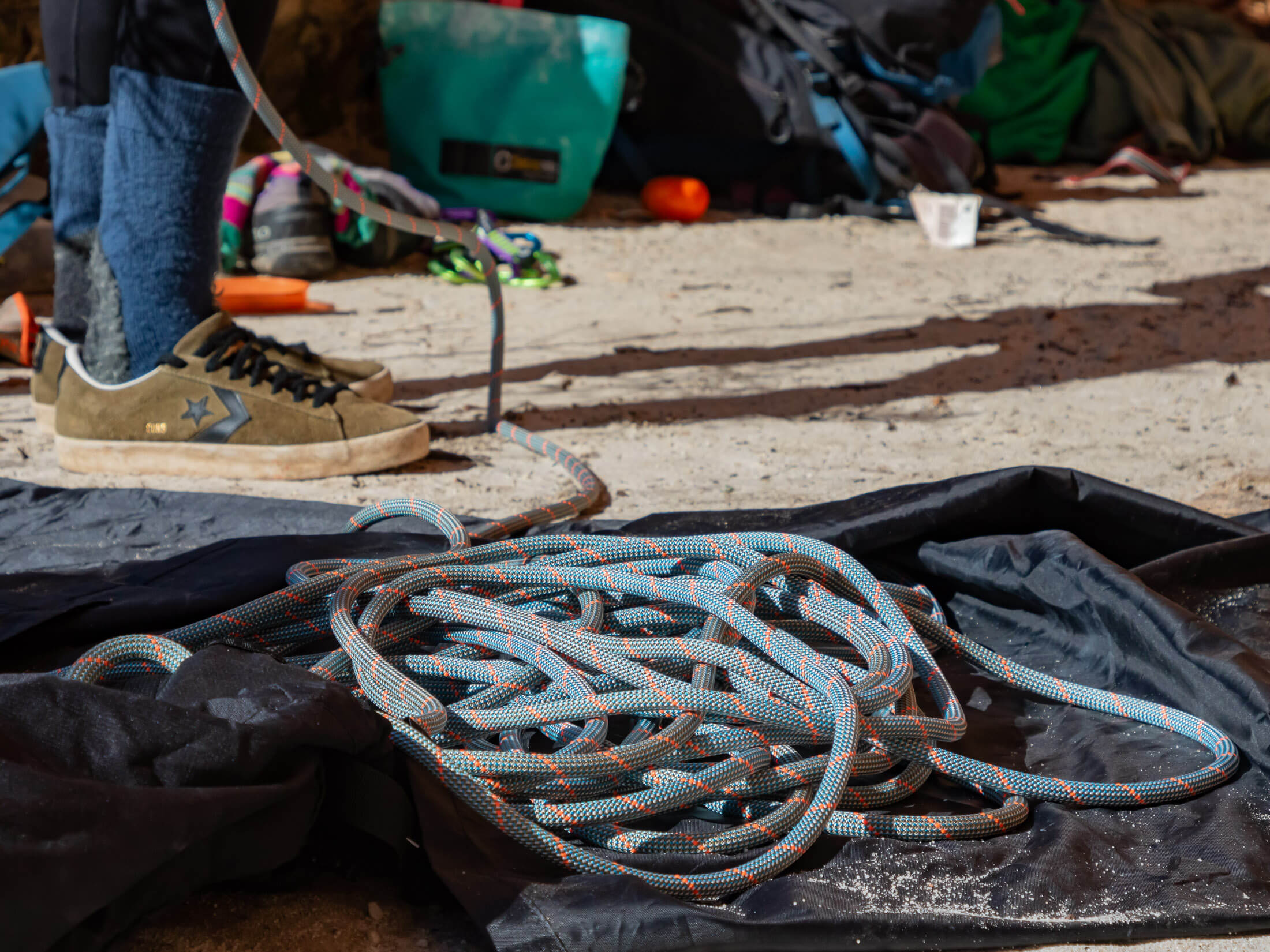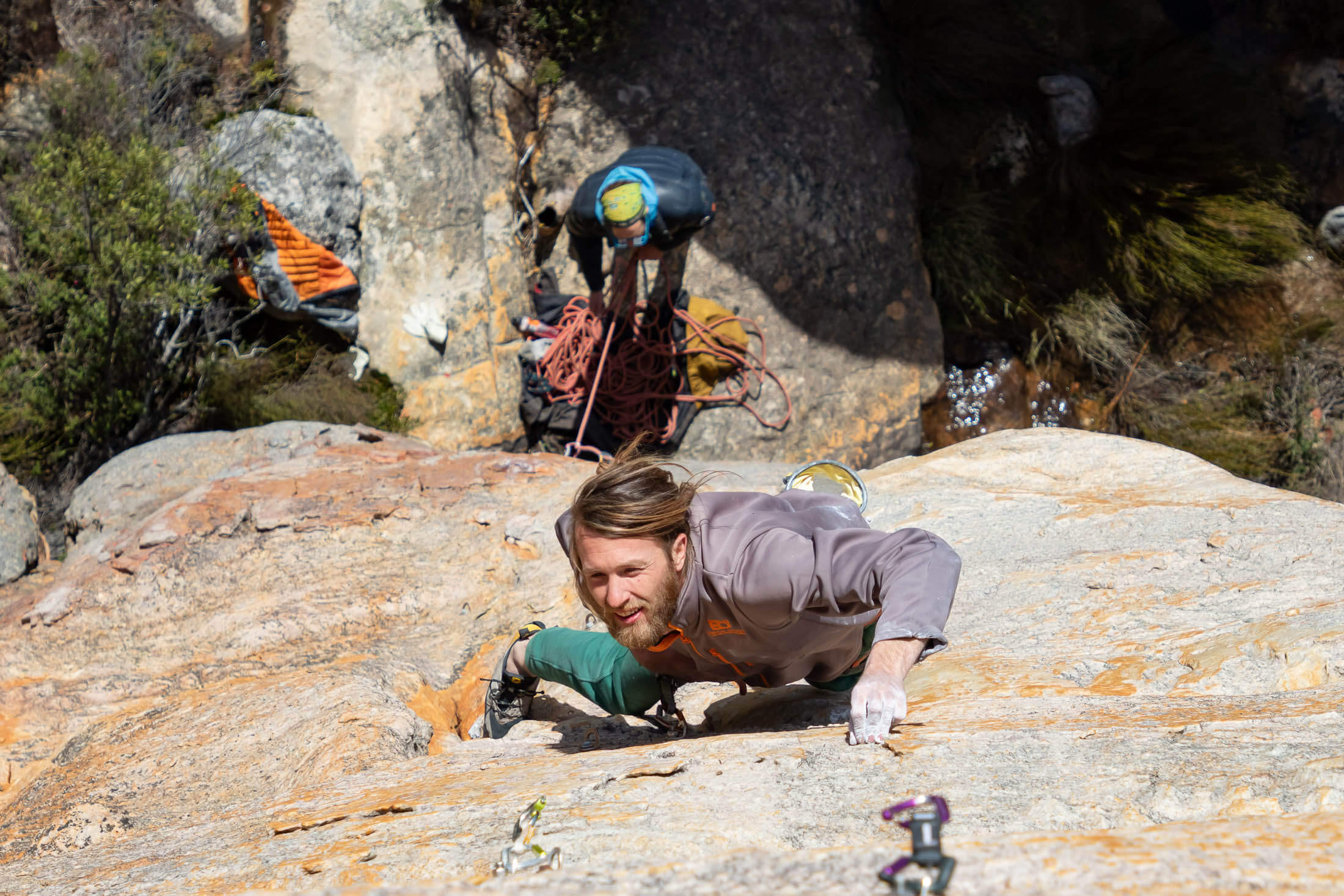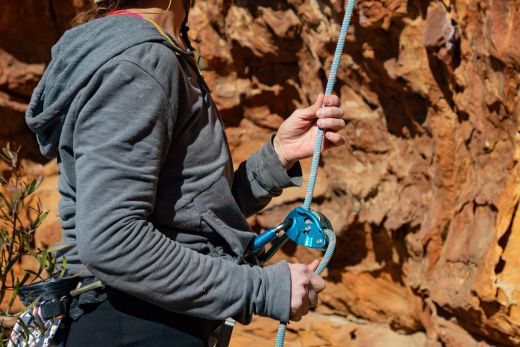Once you have decided on whether you want a single rope or double ropes, the next question is should you fork out an extra $50 to $100 for a dry treatment. Although primarily designed to help ice climbers and alpine climbers avoid the problems associated with wet ropes, a dry treatment also has benefits for climbers who will only use their ropes in dry conditions. Are these secondary benefits worth the extra cost? Read on, and you can decide for yourself.&
The dangers of wet ropes
Besides that fact that a wet rope is heavier, there are good reasons you shouldn’t climb with a wet rope, regardless of whether it’s treated or untreated.
Reduced dynamic strength
The biggest reason to not use a wet rope is that the absorbed water reduces a rope's ability to elongate when it's weighted. Because it’s less stretchy, a wet rope absorbs less energy when loaded suddenly as it would be when you fall on it. This reduces its dynamic strength and makes falls harsher. The net result is a rope that is easier to sever or damage.
Poor handling
A wet rope is both heavier and stiffer, both of which make it more difficult to belay, clip, and rappel with. Worse yet, in very cold weather, a wet rope can freeze, making it almost impossible to knot or use with a device. Now add the challenge of gloved hands and reduced dexterity… you get the idea.
What is a dry treatment?
A dry treatment is a water repellent coating that is applied to a rope to make it more resistant to absorbing water. Typically these treatments are one of two types: Sheath + core or sheath only.
Sheath + core treatments
To be considered ‘Dry’ or water repellent, a rope has to be certified by the UIAA as water resistant. Only ropes that have had both their sheath and core treated can offer this level of water resistance, and even then, not all sheath-plus-core-treated ropes pass the UIAA test. Does the certification matter? That depends on the type of climbing you do. For cold, wet, or snowy conditions, it certainly will since you’ll want to keep water absorption to a minimum. To pass the UIAA test, a rope has to absorb 5% or less of its weight in water. That is a significant improvement on sheath-treated ropes, which absorb around 20 - 40% of their weight in water, and non-treated ropes, which absorb around 50%.
Sheath-only treatments
While sheath-treated ropes don’t offer the same level of water resistance as fully dry ropes, they do have their advantages. They offer greater abrasion resistance than non-treated ropes and are pretty good at stopping sand and dirt from getting through the sheath, both of which increase a rope’s longevity. And they’re less expensive than fully dry ropes. How do you tell a sheath-treated rope from a non-treated rope? A few manufacturers have tried to make this easier for customers by using designations like ‘Protect’, (used by Mammut) to label their sheath-treated ropes. Hopefully this catches on, and it becomes the norm to see product specs include the type of treatment if a rope has one.

Advantages of dry ropes
The intended benefit of a dry treatment is to limit the amount of water a rope absorbs, but the addition of a protection coating also makes dry ropes more abrasion-resistant and durable.
Water resistance
Dry treatments don’t make a rope waterproof. Regardless of the level of treatment, your rope will still get wet when exposed to moisture. But they do dramatically increase water resistance, which reduces the amount of water your rope absorbs. The less water a rope absorbs, the less elasticity and dynamic strength it loses when it becomes wet. Safety concerns aside, a rope with less water in it will also be lighter, less stiff, and easier to handle – belay, clip, and rappel with.
Warning: A dry treatment will wear off over time, especially when used on rock. Additionally a rope’s fibres will break down with continual use, and the weave will become looser. All of these result in a rope absorbing more water with time and use. If you climb both rock and ice, it would be best to have two ropes: a dedicated sheath-plus-core-treated rope for ice climbing and a sheath-treated (or non-treated) rope for rock.
Abrasion resistance
The most significant by-product of a hydrophobic coating is that it reduces the surface friction on a rope’s sheath when it is pulled over rock. This adds a degree of abrasion resistance to your rope, meaning that it will take longer to get fluffy than an untreated rope would. Besides increasing abrasion resistance, a dry treatment also prevents sand and dirt from getting through the sheath. By keeping out particles that would break down a rope’s fibres over time, a protective coating can also increase the lifespan of a rope even if it is only used in dry conditions.
Downsides of dry ropes
There are only two potential downsides to a rope. I say potential because the second won’t be seen as a downside to some climbers.
Cost
The biggest downside to a dry-treated rope is that it costs significantly more than a non-treated rope – at least $50 more for a fully dry 60m rope. Whether or not the additional cost is worth it will depend on your priorities and the type of climbing you do. If you are into ice climbing, alpine climbing or adventure climbing, a dry treatment is indispensable. If you are going to use it in dry conditions, a decision might come down to how durable you want your rope to be.
Slickness
The slickness of a dry rope has both advantages and disadvantages. On the upside, the reduced friction means that a treated rope is subjected to less abrasion than a non-treated rope. On the downside, a treatment makes a rope more slippery, which means that it will pass through a belay device more smoothly than a rope that already has some fuzz on it. While this might make it easier to pay out rope, it can also increase the amount of force needed to lock the rope in a belay device – something to keep in mind when using a new dry rope.
Who needs a dry rope?
Dry treated ropes are designed for ice climbing, alpine climbing and mountaineering – any activities in which a rope is likely to get wet – but they have benefits in other applications too.
Ice climbers and alpine climbers
For ice climbing and alpine climbing, going with a fully dry sheath-treated rope is no-brainer. In these activities, there is both a high chance of a rope being exposed to water or snow and a good chance that it would then freeze, given the likelihood of cold temps. Almost all twin ropes and dual-rated ropes intended for ice climbing are UIAA water resistant certified for this exact reason. When choosing a rope for this purpose, it helps to look not only at whether a rope is UIAA certified as water resistant but also at how it fared in water absorption tests. The pass mark is 5%, but some ropes absorb as little as 1.5%.
Trad climbers
Adventure climbing often involves pitches that are a little chossier, a little mossier, and allround a little dirtier than the rock found in established crags, so it helps to have a rope with a sheath that will be resistant crud if you’re into this style of climbing. But it can also be hard to keep your rope out of the dirt while climbing popular and more trafficked crags. Even though the pitches themselves might be cleaning, you might find yourselves having to stack it on the ground without the protection of a rope mat – something you are unlikely to have with you when multi-pitch climbing. If this sounds like your average climb, you would benefit from a sheath-treated rope.
Sport climbers
Although a sheath-treated rope will also last longer than a non-treated rope when used for sport climbing, the additional cost is likely to offset the increased longevity of a dry rope. As for a sheath + core treated rope, it’s really hard to justify the price, when the rope is unlikely to get wet or get dropped in the dirt frequently. The decision here might just come down whether you want your rope to last longer and are prepared to pay for it.

How to wash and care for a dry treated rope
As you might guess, washing your rope with excessive vigour can contribute to the removal of a rope’s dry coating. When you need to clean a dry rope, this is how you should do it.
How to clean a dry rope?
Firstly, it’s best to hand wash a dry rope in lukewarm water. If you use detergent, only use a rope or tech wash (designed for synthetic fabrics). Second, it would be best to not use a rope brush, which can be quite hard on a dry treatment. Rather pull the rope through a wet rag (best performed while the rope is under water). Once you’ve pulled the whole rope through the rag, drain the dirty water, fill your tub with clean water, and then swish the rope around to give it a good rinse.
How to dry a treated rope after it has been washed or become wet?
Regardless of whether your rope is wet because you washed it or because it landed in the river, the method for drying it is the same. Flake it out onto the floor, preferably indoors and out of direct sunlight, as the UV rays can cause damage to the nylon. It should be away from a direct heat source but in an area with good air circulation. Also keep in mind that the chemicals in household cleaners and the acid in car batteries can permanently damage your rope, so be careful where you lay it out.
Get more advice from this gearhead
You now have everything you need to know about dry ropes. But don’t stop here. On this website you’ll find many more in-depth gear guides on everything from trad gear to rock shoes as well as many more how-to articles. You can find these under the different sections in the categories menu, or, better yet, sign up for my newsletter to get all the latest from Trail & Crag delivered straight to your inbox.
